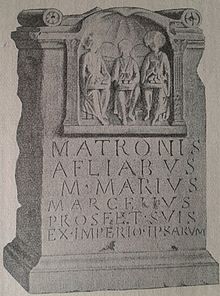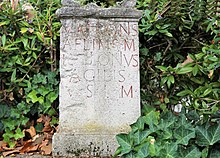Matronae Afliae
The afliae are matrons that have been handed down in four inscriptions on votive stones from Cologne , Wesseling , Inden-Pier and Jülich .
Inscriptions
The votive stone from Cologne was found in 1829 during demolition work on “Appellhofplatz” as a construction in the entrance of a Roman wall tower (tower 7 of the old city wall). The stone (100 × 60 cm) shows a conspicuously well-preserved shell niche with three matrons in the usual hooded costume, supported by two pilasters with leaf capitals , above the inscription field . On the sides of the upper edge above the cornice, two scaled or foliage-decorated volutes are attached to the outside . A servant, presumably a sacrificial servant, dressed in tunics is shown on the left and right of the narrow sides.
"Matronis / Afliabus / M (arcus) Marius / Marcellus / pro se et suis / ex imperio ipsarum"
“For the Matronae Afliae. Marcus Marius Marcellus set up the altar for himself and his family on the orders of the matrons. "
The inscription shows the "ex imperio" formula (i.e. at the behest / instruction of the matrons), which is common in the inscription catalog of the Germania inferior , which it classifies as a revelation inscription and is considered "un-Roman" and therefore characterizes the inscription as native, Germanic.
The stone from Wesseling is a rectangular altar with a base and cornice and a slightly damaged gable between two ornate volutes on the outer edges. A plate is centered at the top. The narrow sides each show trees as a decoration.
"Matronis / Aflims M (arcus) / Iullionius / Agilis / v (otum) s (olvit) l (ibens) m (erito)"
A stone comes from Inden-Pier, which was found during prospecting in advance of the Inden opencast mine (Inden II) in 1985 of a Franconian Merovingian burial ground as a spoil.
"[M (atronis?)] Afli [abus (?)] / [3] Here [nnius (?)] / [H] ospi [talis (?)] / [E] x im [p (erio) pro] / [se] et s [uis l (ibens?) m (erito)] "
From Jülich comes a fragment of which only the first line has survived in rudimentary form and which is conjugated as the nickname of the Afliae.
"Mat [ronis] / Afl [ims] / ["
Epithet and interpretation
The surname has a Germanic dative plural ending - ims in the form Matronis Aflims ( Afliabus the Latin dative pl. -Bus ), which is a small group of Matronenbeinnames (besides Matronis Aflims the Gabims, Saitchamims, Vatvims) from the narrower one Findraum Köln – Wesseling – Jülich shows. Due to the Germanic ending, the assumption of a Germanic root word is obvious. Unlike Galsterer that is not the name first as interpretable with no clear word stem (Germanic or Celtic) is, linguists have (Altgermanisten) has long been on the trunk Germanic * afla- out in the forms Norse afl , Old English afol and Old High German afla with the meaning "strength, power" is proven and offers itself as appropriate. The epithet can be interpreted as the "strengthening, strength-giving matrons".
See also
literature
- Brigitte Galsterer, Hartmut Galsterer : The Roman stone inscriptions from Cologne. IKöln². (= Cologne research. Volume 10). with the participation of Stefan Breuer, Bettina Goffin, Michael Herchenbach, Stephan Meusel, Sabine Schmall and Stefan Schrumpf. Philipp von Zabern, Mainz 2010, ISBN 978-3-8053-4229-2 , p. 121 No. 118.
- Siegfried Gutenbrunner : The Germanic god names of the ancient inscriptions. Max Niemeyer, Halle / S. 1936, pp. 161f.
- Andreas Kakoschke: Annotationes Epigraphicae II. On some inscriptions from the two Germanic provinces. In: Frankfurter Electronic Rundschau zur Altertumskunde 27 (2015), pp. 20–42; here 30–33.
- Günter Neumann : The Germanic matron names . In: Matronen und related deities (= supplements to the Bonner Jahrbücher 44). Rheinland-Verlag, Cologne / Habelt, Bonn 1987, ISBN 3-7927-0934-1 , pp. 103-132 = Astrid van Nahl, Heiko Hettrich (eds.): Günter Neumann: Name studies on Old Germanic (= supplementary volumes to the Reallexikon der Germanischen Antiquity, Vol. 59). de Gruyter, Berlin a. a. 2008, ISBN 978-3-11-020100-0 , pp. 253-289; here 47, 260 ( fee-based Germanic antiquity online at de Gruyter ).
- Hermann Reichert : Lexicon of Old Germanic Names , Volume I, Part 1: Text Volume. (= Thesaurus Palaeogermanicus . 1,1). With the collaboration of Wilibald Kraml. Publishing house of the Austrian Academy of Sciences, Vienna 1987, ISBN 3-7001-0931-8 .
- Rudolf Simek : Lexicon of Germanic Mythology (= Kröner's pocket edition . Volume 368). 3rd, completely revised edition. Kröner, Stuttgart 2006, ISBN 3-520-36803-X , p. 5.
Web links
Remarks
- ↑ CIL 13, 8211
- ^ BH Stolte : The religious conditions in Lower Germany . In: Wolfgang Haase (Ed.): Rise and Fall of the Roman World , Vol. II 18, 1 Religion (Heidentum: The religious conditions in the provinces). Walter de Gruyter, Berlin / New York 1986, ISBN 3-11-010050-9 , pp. 591-671; here 662ff.
- ↑ CIL 13, 8157
- ↑ AE 2001, 1432
- ^ AE 2010, 1000

